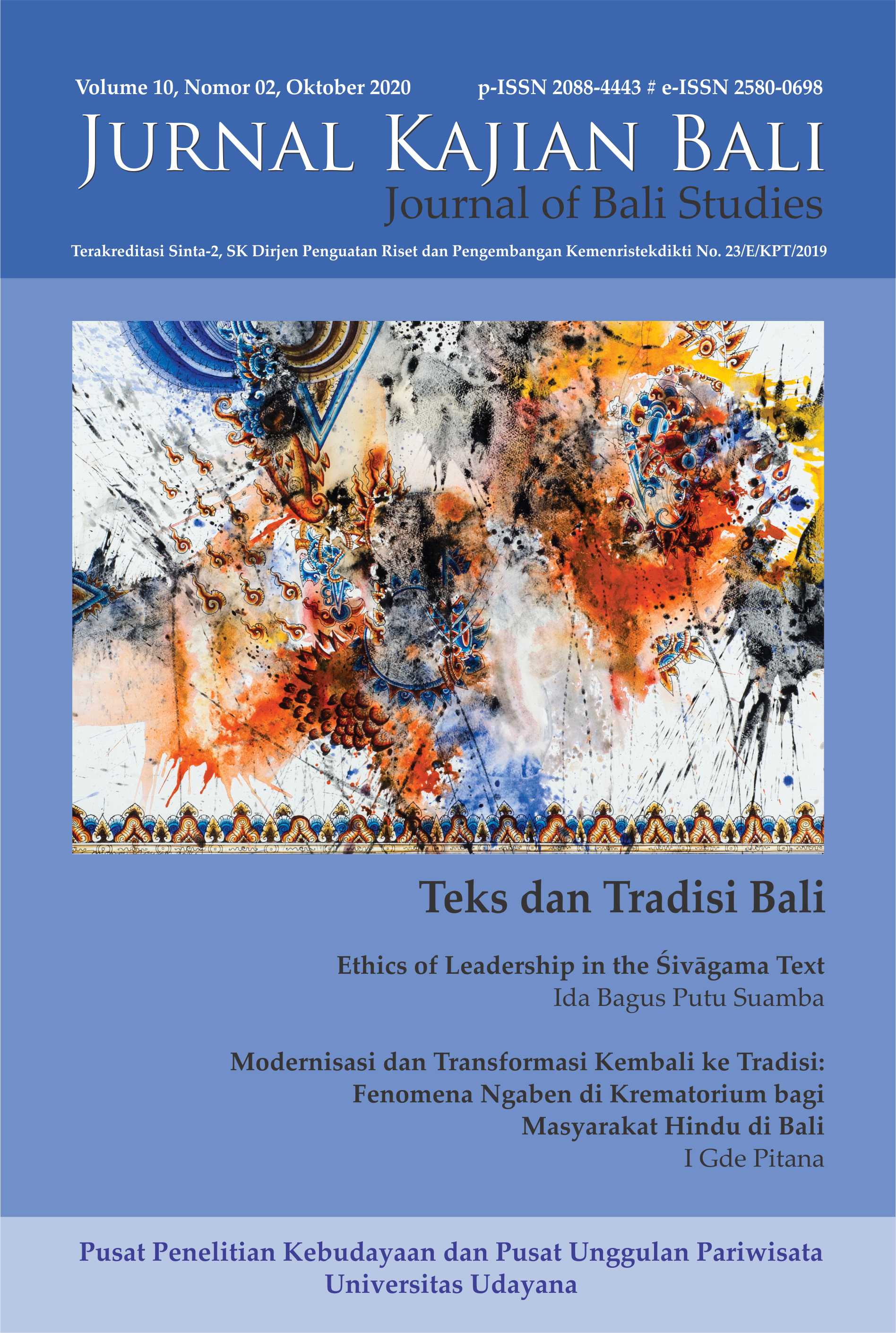Verba Bahasa Bali dalam Ranah Perkebunan Kopi: Analisis Metabahasa Semantik Alami
Abstract
This research is a qualitative descriptive study that aimed to determine the semantic structure of Balinese verbs in the realm of coffee plantations with the natural semantics metalanguage theory. The research location was Pucaksari Village, Busungbiu District, Buleleng Regency. The method used to explore data is qualitative. The method used in collecting the data were interview, listening, conversation, and elicitation. The results of the study show that there are eight verbs used in the realm of coffee plantations, include mamula (plant), numbeg (hoe), ngetep (cut), nyambung (connect), ngalap (picking), nyeruh (pound), nyemuh (dry in the sun), and nambunang (collecting). Verb mamula, numbeg, ngetep, nyambung, nyeruh, nyemuh and nambunang having an original meaning ‘do’ that has a polysemy with the original meaning ‘happen’ and it has the exponent X do something to Y, something happened to Y. Verb ngalap andnambunang have the original meaning do has a polysemy with ‘moving’. They have exponent X do something about Y, Y move.
Downloads
References
Citrawati, Dewa Ayu Carma. (2017). “Makna Leksikon yang Berelasi dengan Air dalam Bahasa Bali”.Tesis, Program Studi Magister Ilmu Linguistik, Fakultas Ilmu Budaya, Universitas Udayana.
Dewi, Anak Agung Alit Novita. (2016). “Struktur dan Peran Semantik Verba Menyentuh Bahasa Bali: Kajian Metabahasa Semantik Alami”. Tesis, Denpasar: Fakultas Ilmu Budaya Universitas Udayana.
Goddard, Cliff. (1996). Semantic Theory and Semantic Universal (Cliff Goddard Convensor) Cross Linguistic Syntax from Semantic Point of View (NSM Approach) 1-5 Australia.
Goddard, C. Wierzbicka, Anna. (1994). Semantics and Lexical Universals. Studies In Languages Companion Series 25. Australia: University of New England.
Lestari, Denok. (2018). “Verba Ujaran dalam Bahasa Bali”. Jurnal Kajian Bali. Volume 08 Nomor 02, pp: 125-142.
Mahsun. (2011). Metode Penelitian Bahasa: Tahapan Strategi, Metode, dan Tekniknya. Jakarta: PT Rajagrafindo Persada.
Mulyadi. (1998). “Struktur Semantis Verba Bahasa Indonesia”. Tesis, Program Studi Magister Linguistik, Universitas Udayana.
Parwati, Sang Ayu Putu Eny.(2018). “Verba Memasak dalam Bahasa Bali: Kajian Metabahasa Semantik Alami (MSA).” Aksara, Vol. 30, No. 1, pp.121-132. DOI: http:// dx.doi.org/10.29255.
Sudipa, I Nengah. (2004).”Verba Bahasa Bali: Sebuah Kajian Metabahasa Semantik Alami”. Disertasi Program Doktor Linguistik, Universitas Udayana.
Sudipa, I Nengah. (2012). “Makna Mengikat Bahasa Bali: Pendekatan Metabahasa Semantik Alami”, Jurnal Kajian Bali, Volume 02 Nomor 02, pp: 49-66.
Sutjiati-Beratha, NL. (1997). “Basic Concepts of a Universal Semantic Metalanguage.” Linguistika Tahun IV Edisi Keenam, pp: 110-115.
Sugiyono. (2020 [2008]). Metode Penelitian Pendidikan, Pendekatan Kuantitatif, Kualitatif, dan R&D. Bandung: Alfabeta
Spolsky, Bernard. (2003). Sociolinguistics. (Cetakan ke-4). Oxford: Oxford University Press
Tim Penyusun Kamus. (1983). Kamus Bali-Indonesia. Denpasar: Dinas Pendidikan Dasar Provinsi Bali.
Tim Penyusun Kamus. (2008). Kamus Bali-Indonesia Beraksara Latin dan Bali. Denpasar: Badan Pembina Bahasa, Aksara dan Sastra Bali bekerjasama dengan Dinas Kebudayaan Kota Denpasar.
Widani, Ni Nyoman. (2016). “Makna Mengambil Bahasa Bali: Pendekatan Metabahasa Semantik Alami (MSA)”, Retorika: Jurnal Ilmu Bahasa, Volume 2 Nomor 1, pp: 128-141.
Wierzbicka, Anna. (1996). Semantics: Prime and Universal. Oxford: Oxford University.
Wierzbicka, Anna dan Cliff Goddard. (2014). Words and Meanings. Oxford: Oxford University Press.

This work is licensed under a Creative Commons Attribution 4.0 International License.



















